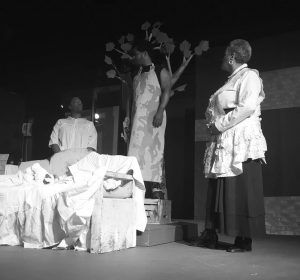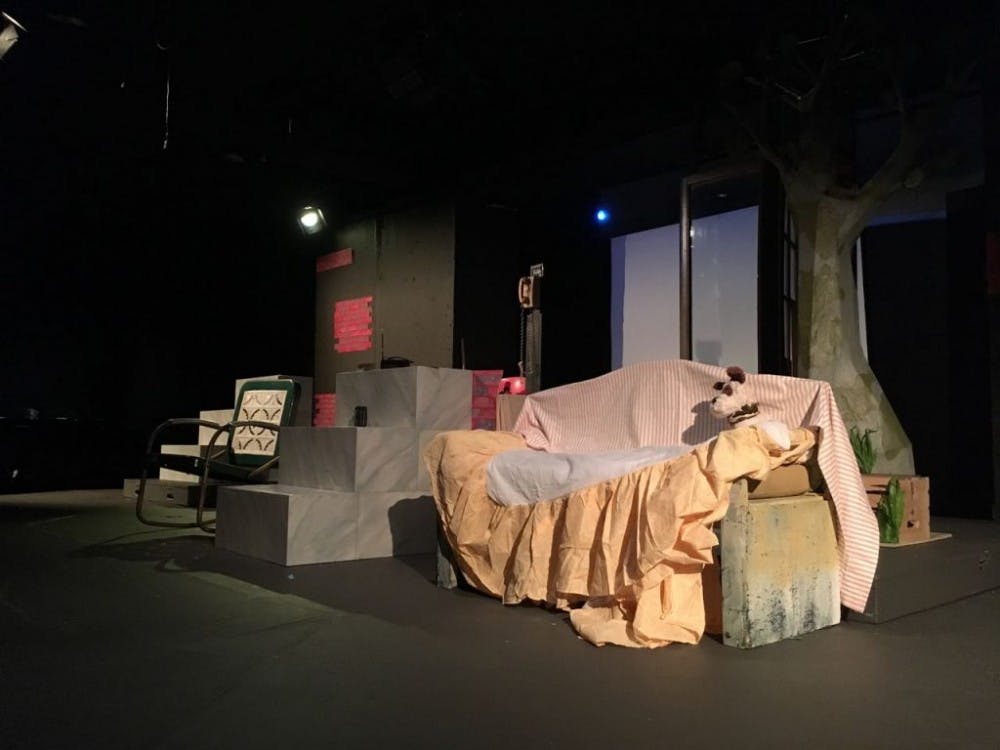An unassuming brick building, hardly distinguishable from those around it and tucked away in an unassuming corner of Baltimore is the Arena Players.
The Arena Players may not at first appear to be anything special. However, one may be surprised to discover that it is the longest continuously operating African-American community theater in the U.S., according to their website. And yet as I got out of my Uber, unsure whether I was at the right place, I was about to discover that it was even more than that.
I’d come to see The Last House Standing: A Play About the Highway to Nowhere. I was walking in blind, knowing nothing besides what the Facebook event had told me. Inside, there wasn’t a great deal else to see, besides an immediate sense of community — the kind you get when you walk into a church. I bought my ticket and went to find a seat.
The atmosphere of the show was immediately established by Sheila Gaskins, the director and playwright. She told the audience that she’d been working on the play since 2009 and was reinvigorated to revive it after the uprising, as she described it, in 2013.
“There may be some flaws and glitches... don’t worry about that,” Gaskins said.
To me, one well acquainted with the theatre and therefore used to an obsession with getting everything perfect, this sentiment was endearing and refreshing.
Then, Gaskins had us do three things. She told us to turn to our neighbors and introduce ourselves, she told us to take a deep breath and let it out and then she told us to think of something funny and just laugh. Afterwards she quipped “I thought it was funny when he won too,” which elicited another wave of chuckles. With that, the play began.
As the stage went dark, a projection came up on the back curtain, and a short documentary played, educating the audience about “the highway to nowhere”, also know as Interstate 170, which began construction in the late ‘60s and for which the government relocated 19,000 residents.

The plot of the play follows a family struggling resiliently to hold onto what is rightfully theirs while dealing with the reality that they have no choice but to move once they are literally the last house standing. The principal protagonist, EV, was portrayed by actress Taylor King who has been featured on HBO’s The Wire. EV has the most trouble dealing with the reality that they need to leave the house that her ancestors moved into. EV has a dream of her Grandma Chase, portrayed by Karen Chase, in which she learns of the importance of respecting the equality of everything, including trees and stairs.
A particularly memorable scene occurs in the vision when the marble steps to the house next door come to life in the form of “The Marblettes.” The three performed renditions of various soulful songs in what was quite a stirring and beautiful moment. It conveyed the theme that even objects as ordinary as front step hold a unique history and personality.
This theme was further driven home with a conversation EV has with a tree in their front yard, played by actor Larry Lancaster. Charismatic and powerful, Lancaster’s portrayal of the tree helped to cement the message that, although his roots were torn up by the British in the 1600s, he stands tall and strong.
It was a clear metaphor for the history of African-Americans in the U.S., and it worked well. Once EV awoke, she took several actions to fight the government, starting a petition and organizing protests, which the audience took part in.
In the end, EV’s mother, portrayed by Sharonda Fisher, teaches her that while she made a valiant effort, sometimes it is as important to keep your head high and move on in defeat, as it is to fight in the first place.
Also worth mentioning is Winston Parks-Bey’s performance as an arabber, a slang term for a street merchant who sells fresh produce from a colorful horse drawn carriage, and Roy, EV’s father. He showed up as the arabber numerous times throughout the play to give the audience a brief interlude from the normal progression of the plot.
The character explains that arabbing was once a common profession and has largely died out. Parks-Bey’s character filled an almost Stage-Manager-from-Our Town-type role in his parley with the audience and in Parks-Bey’s affable charm.
Another oddity was the disembodied voice of Gaskins in the role of narrator and coach. While she clearly had scripted sections, she also spoke freely with the audience and the actors, at times saying it was okay for us to applaud, telling an actor to speak up or pick up a prop when it fell over. While unconventional, and at risk of appearing unprofessional, this aspect only added to the performance and made me feel a part of the experience of the play rather than a passive viewer. As Gaskins had said at the beginning when we’d greeted our neighbors, it truly felt like we were “a community of friends.”
Overall, the play, for all of its quirks and oddities, was not only an enjoyable experience, but also an educational one. It was one of the first times I have felt like I’ve gotten a really clear glimpse into Baltimore’s community and history. It was also a reminder of what theatre can and should be: a representation of people and situations which matter and which ought to be remembered and exhibited.
After the show, Gaskins welcomed audience members to stand up and give their thoughts and feedback about the production. I found myself in a kind of reverie when many stood up and spoke about their memories of “the road to nowhere,” or how they had been an arabber in their youth.
The Last House Standing was not the kind of theatre you experience when you go see The Odd Couple or The Book of Mormon. But maybe it should be the kind of theatre we see much more often.
The Last House Standing was performed for the final time in this iteration this past Sunday.

Director Gaskins is known as a member of the Theater Action Group which states on its website that it “utilizes theatre, visual arts, storytelling, music, and dance to incite meaningful dialogue around challenging topics or specific issues.”
Gaskins is also known for the open letter she penned to the Baltimore art scene (published in CityPaper last October) in which she sought to address some of the problems facing people of color in the art scene.
The Arena Players’ 2016-2017 season continues with a comedy, Moms Mabley: My One Last Nerve premiering on Saturday for a short, two-show run, which ends on Sunday. Sandra Meekins is starring as Moms Mabley.
Moms Mabley was the stage name of comedian Loretta Aiken who was active from the 1920s through the 70s. She was known for her direct jokes that tackled issues like racism. She was also one of the first performers to openly come out as gay when she announced that she was a lesbian at the age of 27. My One Last Nerve features Meekins acting as the character of Mabley.
Another performance at Arena Players to look out for is the March play, 3 Guys in Drag Selling Their Stuff. The play debuts on March 10 and lasts until March 26.
General admission for all these plays is $20.





